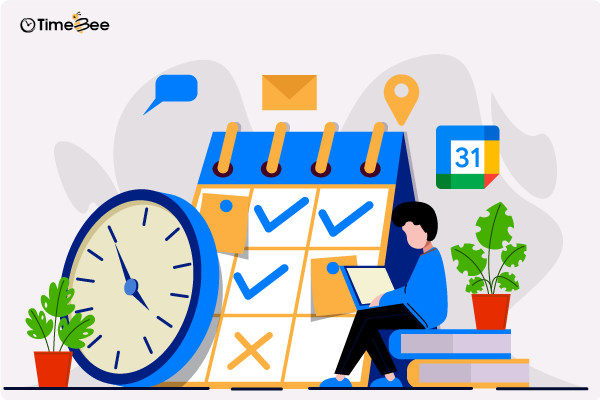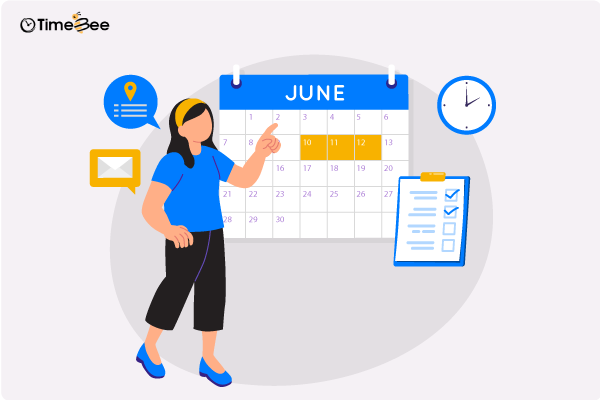Content
Content
Time management is organizing and planning how to divide limited hours between tasks. An effective time management plan ensures productivity and brings discipline to personal and professional life.
Businesses must develop detailed plans to align their workflows. A significant factor in creating a plan is the time required to complete the tasks. Typically, employers hand the plan to employees and ask them to figure out how to manage it. A wise manager would help them create a time management plan that will help them execute it.
In a setting where workers are aware of their time distribution, they are less likely to experience burnout.
Here are six steps that you can follow to create a plan for yourself and your employees.
1. Assess Current Situation
Conduct a thorough assessment of your organization’s current time management practices and check your employees’ productivity metrics.
Arrange meetings, surveys, and interviews with the employees to identify bottlenecks, inefficiencies, and areas for improvement. Analyzing the ongoing practices will assist you in allocating time to various tasks and projects.
In addition, it will help you pinpoint areas that need improvement. The assessment should cover all aspects, including the calculation resources, the current trends, and the anticipated changes that can affect the goal.
2. Set Clear Goals and Priorities
Setting clear goals is the foundation of any good time management plan. People usually follow the SMART system.
- Specific: State the goals clearly and precisely. Vagueness can cause misunderstandings and hinder productivity.
- Measurable: Set tangible standards for tracking progress.
- Achievable: Don’t set unrealistic goals. Make sure the goals can be attained with the available resources and time.
- Relevant: Don’t forget the purpose of the goal. Align the goals with long-term objectives.
- Time-bound: Set the deadline.
In a business, an employee may have multiple goals related to different projects. Usually, employers help employees prioritize tasks. Ask them to prioritize tasks in the morning as per their time and work this way throughout.
3. Define and Allocate Time to Each Task
Tasks are the mini goals that you set to achieve the bigger goal. They are, by nature, the most important part of what you or your employees do on a daily basis.
To construct an effective time management plan, you must follow the same process as creating a goal. First, identify and list all tasks necessary to achieve your team’s goals.
Like your goal, these tasks should follow the SMART rule. While creating tasks, consider their short-term and long-term implications. This process helps clarify expectations and provides a roadmap for execution.
Once you have created a list of tasks, prioritize them accordingly and estimate the time needed to complete them. You must consider all factors, such as complexity, the skill level required, and the challenges an employee may face while executing the task.
The Eisenhower Matrix technique can be used to prioritize tasks properly. This method categorizes tasks into four distinct groups:
- Urgent and Important: First priority.
- Important but Not Urgent: These tasks can be done later.
- Urgent but Not Important: Pass them on if possible.
- Neither Urgent nor Important: Not necessary, can be dropped.
Looking for a Tool to Set Goals and Prioritize Tasks?
Use TimeBee
4. Create a Schedule
Creating a schedule is a pivotal aspect of effective time management. It provides structure and organization to your team’s workflow. Moreover, It guides employees through their daily tasks and responsibilities while ensuring that deadlines and resources are utilized efficiently.
First, you must identify the key activities and tasks that must be accomplished within a given timeframe to create a workable schedule.
This process may include continuous meetings with employees and clients, if any. Through this communication, you can understand the scope of work involved and identify which activities are accounted for in the schedule.
One thing to remember while adding activities to the schedule is to maintain a workload balance for your employees. A skewed balance can mean higher stress and lower productive output.
So, make sure that you include breaks and periods of recovery in your schedule. Creating a buffer time between tasks or activities allows employees to handle unforeseen circumstances without compromising the schedule.
5. Identify Potential Distraction
Distractions are a part of life, and it is impossible to eliminate them. However, one can reduce them with a little more planning and practice. For your time management plan to work, be aware of the distractions and create strategies to avoid them.
Workplace distractions may include interruptions from coworkers, excessive emails or notifications, phone calls, social media browsing, or noise pollution. To minimize them, you must identify which of these your workplace has.
You can identify them by observing the patterns or asking your employees what bothers them during work hours. Also, focus on details such as the type of distraction, its duration, and its impact on productivity.
With insights from the assessment, develop and implement strategies to manage distractions effectively. Here are a few that you can implement.
- Set boundaries around communication channels.
- Establish designated focus periods.
- Conduct focus training.
- Implement technology solutions to block distracting websites or notifications.
- Create policies for mobile usage.
Following a time management plan will be much easier once your employees are trained to maintain their focus.
6. Revise and Regulate
Before implementing the time management plan, you need to revise it. It allows you to evaluate progress, identify areas for improvement, and make necessary revisions to optimize productivity and achieve desired outcomes. Here is how you can revise your plan.
- Schedule weekly, monthly, or quarterly meetings to review the performance of your time management plan.
- Conduct surveys and one-on-one meetings with employees or clients to gather insights and feedback about the current plan.
- Utilize performance metrics and key performance indicators (KPIs) to assess the effectiveness of your time management plan.
- Evaluate the strengths and weaknesses of your time management plan based on the feedback you receive and the analysis of performance metrics.
- Make necessary adjustments and revisions to your time management plan. This may involve changing schedules, reallocating resources, or implementing new strategies.
- Communicate any changes or updates to the time management plan.
- Track progress against revised goals.
It is essential to understand that a plan may require continuous revisions, and trends and requirements may change over time. Being flexible and adaptable is key to refining your time management plan and achieving the goal for which you created it.
Ready to start devising a time management plan?
Check out our in-depth blog on the importance of time management here.
Time Management with TimeBee
A time management plan will not help you as much if you don’t have a way to measure it.
TimeBee is an app that can help you implement your time management plan and provide insights about its effectiveness. It streamlines and optimizes time management by tracking accurate time against task and employee activity. TimeBee can assist you with your time management plan in the following ways.
- Task Time Tracking:
TimeBee allows employers to track tasks and projects in real-time, providing visibility into progress, deadlines, and resource allocation. With this feature, you can track the time allocated to the tasks in your plan.
- Performance Analytics:
TimeBee provides performance analytics and reports on employee productivity. With these reports, you can monitor employees’ performance according to your plan. Furthermore, you can identify glitches in your plan and make changes accordingly.
- Distraction Management:
TimeBee includes features designed to help users manage distractions effectively. If your employees are idle for too long, they will receive a pop-up notification. In addition, with the web and app tools, you can monitor their productive time and provide insight into their time.
- Customization:
TimeBee offers customizable dashboards and reports, as well as personalized task lists and reminders. You can customize it according to your time management plan and achieve the required outcome.
Summing Up
Effective time management plans provide discipline, a key ingredient for success in any professional setting. By implementing a structured approach to managing their day, employees become more accountable, productive, and, ultimately, more satisfied with their work.
When employees have a roadmap, they feel in control of their work and are better equipped to handle challenges during work. So, create a plan that works and encourage them to embrace time management as a valuable skill to be more efficient. The most effective way to manage time effectively is to have the perfect means to measure it.
For A Clear and Effective Time Management Plan
Get TimeBee Today
Similar Reading



